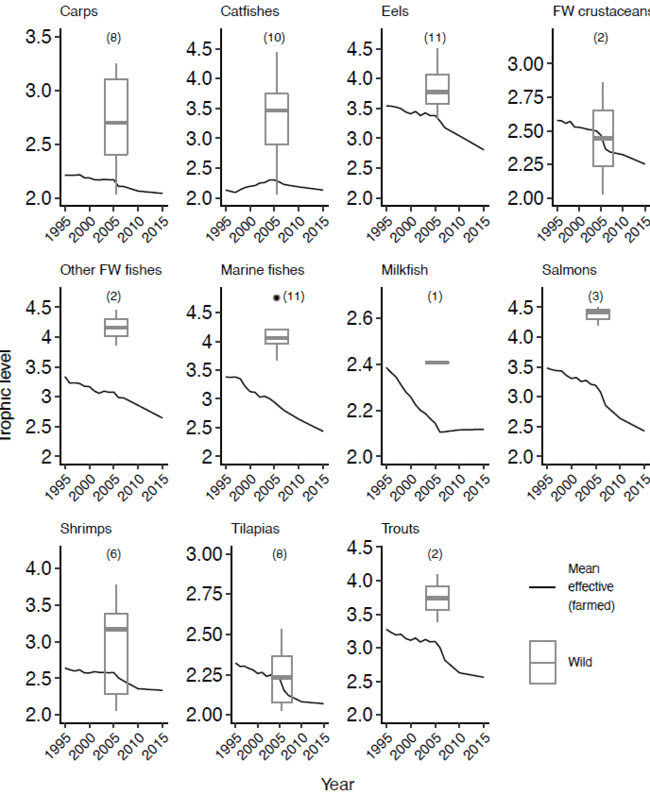
© Aker Biomarine
So argue the authors of a new paper, which looks at how changes in the ingredients used in compound feeds – notably the reduction in the proportion of fishmeal and fish oil – are essentially lowering the trophic levels of traditionally high trophic taxa, such as salmon, that consume these feeds. Among other factors, this should persuade policymakers to think about ways, other than using trophic level indicators, to improve the sustainability of farmed seafood.
“Aquaculture is a rapidly growing sector that is needed to keep up with human demands for fish and seafood. To prevent runaway environmental and social impacts from development of this industry, we require comprehensive and effective policies to regulate it. Trophic level indicators won’t provide this,” lead author, Richard Cottrell, told The Fish Site.
Background
The authors note that “of the 80 million tonnes of food biomass produced by aquaculture, approximately 70 percent is sustained by human-made compound feeds”. The inclusion of forage fish in these feeds has generated concerns over the environmental sustainability of farming carnivorous taxa, such as salmon, and led to widespread calls “to refocus fish farming on low-trophic level species whose natural diets do not include fish”.
Analysis
In order to assess the true trophic level of farmed seafoods the researchers analysed the dietary composition of a range of fed aquaculture species from 1995 to 2015.
They found that, for example, feeds for Atlantic salmon in Norway contained only 15 percent marine protein inclusion, down from 65 percent in 1990. Meanwhile, there is a far greater proportion of ingredients from trophic level 1 [ie terrestrial crops] in salmon feeds.
The researchers add that although the overall species composition of farmed fish has changed and the actual trophic position of those forage fish used in feeds has varied, it is this reduction in fishmeal and oil inclusion that has driven “a substantial reduction in the effective trophic level of aggregate production of fed aquaculture: from 2.63 in 1995 to 2.23 in 2015.”
This varies between taxa, falling from 3.33 to 2.64 for species such as bass and perch; from 3.53 to 2.81 for eels; from 3.48 to 2.42 for salmon; and 3.38 to 2.43 for marine finfish.

(click on image to enlarge) © Cottrell et al, 2021
Overall, changes in the diets mean that trophic level distinctions between species are becoming less clear.
“Herbivorous fish are fed animal protein and thus farmed as omnivores, and carnivores have become omnivores as they are fed proportionally more plant proteins. This reality highlights the problem of characterising any particular taxon as ‘unsustainable’ based only on its wild or historic cultured trophic level. Instead, we must recognise different and dynamic inputs into feeds and the dynamic nature of practices and management used to grow them,” they observe.

“Most farmed seafood is fed using human-made feeds. And these feeds have changed dramatically through time, largely through a reduction in reliance of fish-based inputs and an increase in crop ingredients, which in turn has completely changed the trophic level of the farmed species. Many naturally carnivorous species (such as salmon and other marine fish) are farmed at similar trophic levels to their more herbivorous counterparts. So reference to their wild trophic levels or even historic farmed trophic levels is misleading,” adds Cottrell.
They also note that “some carnivorous species retain certain key nutrients more efficiently than species of a lower trophic level”, making calls for reducing the trophic level of farmed species less compelling.
Furthermore, they question whether the shift away from marine products in the diets of farmed fish is necessarily more sustainable.
“Is shifting away from fish-based to crop-based feeds adding additional and compounding pressure on agricultural systems? Are there any equity implications of this shift? We just don’t know. So it’s not that this means that production of carnivorous and herbivorous species is necessarily equivalent, sustainability-wise, it just means that trophic level indicators don’t account for enough information to tell us. And these trophic level markers will become even less distinguishable across species as feed technologies and innovation improves,” Cottrell reflects.
As a result, they argue that “the dichotomous classification of ‘low’ or ‘high’ trophic level species in policy recommendations is unhelpful, unless explicit recommendations are made”.
The limitations of unfed aquaculture
While they concede that unfed species, such as many bivalves and seaweeds, “may provide considerably more environmental benefits with fewer environmental impacts than fed finfish”, they “serve different market sectors so their value as a reference point is, at best, context-dependent”.
“It is true that unfed production like mussels, oysters and seaweeds are known to perform far better than fed fish in an environmental sense. However, growth in the production of these products is incredibly unlikely to satisfy the growing demands for other seafood products such as white fish or shrimp. Consumer choice and substitution is not a straightforward topic to address,” Cottrell explains.
Equally, they add that the sustainability of the dietary profile of naturally non-carnivorous taxa such as carp or tilapia, needs to be weighed against the efficiency with which they convert feed to edible and nutrient-rich biomass.
Looking ahead, they predict that improvements in feed composition and genetics will “further undercut the value of trophic level as a measure of sustainability in aquaculture”.
Alternative metrics
Instead of focusing on trophic levels, they advocate greater support for feed source transparency policies and participation in voluntary certification schemes, such as those run by the Aquaculture Stewardship Council (ASC).
“Effective aquaculture policy needs to avoid overly simplistic sustainability indicators such as trophic level. Instead, employing empirically derived metrics based on the specific farmed properties of species groups, management techniques and advances in feed formulation will be crucial for achieving truly sustainable options for farmed seafood,” they stress.
They also warn of the dangers of seeking efficient production as the sole goal of aquaculture.
“A world focused solely on efficiency of aquatic food – a world of ‘aquatic chicken’ – would favour globalised, vertically integrated seafood supply chains that would likely limit market access for marginalised communities and reduce the diversity of farmed products to a few key commodities. Thus, efficiency gains in one context may actually compromise the environmental and nutritional benefits of access to seafood for humanity as a whole.
“Instead, a key goal of aquaculture development should be to create species-diverse and nutrient-diverse food sources that remain accessible and appropriate to people across regions and economies. Realising the potential of aquaculture to promote environmental sustainability requires integration of diverse goals, including food system stability, economic development and global equity,” they conclude.
Summing up, Cottrell told The Fish Site: “Under the current world of unbounded economic growth we live in, we will need to know how to most responsibly and equitably meet demands for seafood, including increasingly popular products, under this period of rapid global change. Trophic levels won’t guide us there.”
Further information
An abstract of the paper, Time to rethink trophic levels in aquaculture policy, is now available in Reviews in Aquaculture.




